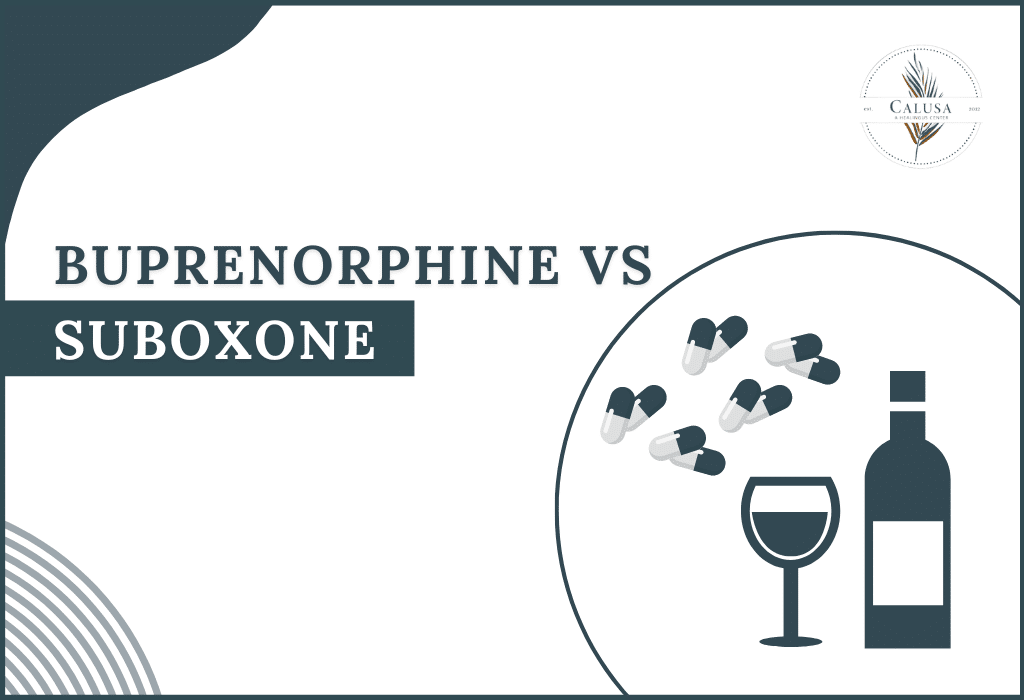Opioid addiction is a very serious problem experienced by millions of people the world over, which necessitates effective treatment programs that will enable these individuals to overcome their dependence and live healthier lives. Buprenorphine and Suboxone are two commonly used medications in treating opioid addiction. Indicating variations and similarities between these two treatments helps struggling addicts make informed choices about recovery.
In this blog post, we will compare Buprenorphine with Suboxone. By the time you finish reading, you will have a better understanding of major differences as well as similarities between the two approaches, enabling you to choose the best way for your own or your dear one’s journey to recovery. With that said, let us delve into buprenorphine vs suboxone and uncover their features.
What is Buprenorphine?
Buprenorphine is a medication that has been widely used for treating opioid addiction. It was first synthesized in the 1960s and gained prominence in medicine during the 1980s. Buprenorphine binds to brain receptors just like other opioids, but it does so without producing a high while reducing cravings as well as withdrawal.
Applications in Opioid Addiction Treatment
- For users who are addicted to such opioids as heroin or morphine or prescription pain relievers.
- Stabilizes the chemistry of the brain, reduces the desire for drugs, and eases withdrawal syndrome.
- Usually employed in combination with counseling and support as part of a comprehensive treatment plan.
Different Forms and Brands
- Comes in tablets, films, and shots.
- Subutex, Zubsolv, and Bunavail are some common brand names.
- Every form and brand has specific ways of administration and doses adjusted to individual needs.
It is important when deciding buprenorphine vs suboxone to remember that Suboxone includes naloxone with buprenorphine which reduces its misuse possibilities further.
What is Suboxone?
Suboxone is a drug used to treat addiction to opioids. It was approved by the FDA in 2002 and it contains two active components: buprenorphine and naloxone. The former helps minimize withdrawal syndromes as well as cravings while the latter prevents misuse of this medication.
Usage during Opioid Addiction Treatment
- Helps manage opioid dependence by reducing withdrawal symptoms and cravings.
- Designed to be part of a complete treatment program, including counseling and support.
- Effective in maintaining long-term recovery and preventing relapse.
Composition: Buprenorphine and Naloxone
- Buprenorphine: A partial agonist that helps in reducing withdrawal syndrome alongside cravings.
- Naloxone: An opioid antagonist that blocks the effects of opioids and prevents misuse of the medication.
This combination makes Suboxone a safer alternative because it reduces the possibility of its abuse.
Various Forms and Brands
- Sublingual tablets and films are available.
- It is commonly known by its brand name Suboxone.
- Zubsolv, as well as Bunavail, are among the other brands with similar formulations.
When comparing buprenorphine vs suboxone one should note that while both contain buprenorphine, there is also naloxone in Suboxone for an additional barrier to misuse.
Mechanism of Action
Opioid addiction treatments aim to reduce withdrawal symptoms and cravings to enable individuals to quit using opioids easily. These treatments often involve medications that interact with opioid receptors in the brain, helping to manage the addiction more effectively.
Buprenorphine’s Mechanism
- Partial agonist of opioid receptors
- Activates receptors but not fully like heroin or painkillers do
- Reduces withdrawal symptoms and cravings
- Offers another option for treating opioid addiction safely
Suboxone’s Mechanism
- Combines buprenorphine with naloxone
- Buprenorphine: Manages withdrawal symptoms and cravings by partially activating opioid receptors.
- Naloxone: An opioid antagonist that counteracts the negative effects of opioids
- If misused by injection, naloxone precipitates withdrawal symptoms, discouraging misuse.
When comparing buprenorphine vs Suboxone, Suboxone’s combination of buprenorphine and naloxone offers an additional safeguard against misuse, which can be a crucial factor in effective addiction treatment.
Effectiveness
Opioid addiction treatments are crucial for helping individuals overcome their dependence on opioids. These treatments are specifically designed to manage withdrawal symptoms, reduce cravings, and prevent relapse, ultimately aiding in recovery. Treating patients effectively can improve their general well-being, and help them regain control of their lives, thereby reducing the risk of overdose significantly. The aim is to guide people on the path to recovery and help them create a firm foundation that does not rely on opioids.
Buprenorphine Effectiveness
- Research shows that buprenorphine is effective in treating opioid addiction by reducing cravings and withdrawal symptoms.
- Clinical studies indicate that patients treated with buprenorphine have higher retention rates in treatment programs compared to those not using medication-assisted treatment.
- Success rates vary, but many patients experience significant improvements in their ability to stay off opioids and lead more stable lives.
Suboxone Efficiency
- Opioid addiction treatment is highly effective by studies involving Suboxone, which combines buprenorphine with naloxone.
- This makes Suboxone safe for a large number of patients as well as helps in preventing misuse.
- According to clinical trials and real-world studies, Suboxone increases retention in treatment as well as prevents relapse.
- Suboxone users often experience better outcomes overall and significantly improved long-term recovery rates compared to those not on this therapy.
Both medications are used effectively to treat opioid addiction. However, the narcotic antagonist naloxone added to sublingual buprenorphine formulation makes it more favorable for many patients and healthcare providers due to its pro-active effects against misuse.
Safety and Adverse Effects
As far as opioid addiction is concerned, safety should take precedence over all other factors. Besides, each of these opiate-addiction treatments like Buprenorphine and Suboxone has their possible side effects that one needs to know before deciding on the right substance for an individual case.
Safety precautions and side effects related to Buprenorphine
Buprenorphine is usually considered safe when taken correctly. However, it can cause certain side effects. Some common ones are:
- Nauseous
- Headaches
- Constipation
- Sleepiness
In rare instances, this medication is associated with several severe problems like allergic reactions or liver issues. For this reason, one should constantly be on the lookout for any unusual symptoms that may show up and consult a healthcare provider when they occur. Generally speaking, Buprenorphine has good safety profiles but like all drugs, some risks are there..
Safety and Side Effects of Suboxone
Suboxone, which combines Buprenorphine with Naloxone, also has its side effects. The most common ones include:
- Headaches
- Nausea
- Sweat
- Insomnia
However, since it contains Naloxone, Suboxone has an abuse-deterrent mechanism although if someone is not using it correctly, they can experience withdrawal symptoms. Even though Suboxone generally has good safety records, it is important to adhere to prescribed dosages and guidelines that minimize risks.
To sum up, the two medications Buprenorphine and Suboxone effectively treat opioid addiction at the expense of potential side effects unique to each. Thus, awareness of these aspects can go a long way in making an informed choice on what could be the best treatment taking into account individual patient needs and health conditions.
Dosage and Administration
Right dosage and administration matter a lot when it comes to treating opioid addiction because these are determinants of effectiveness as well as safety. Both Buprenorphine and suboxone have specific instructions about how they should be used.
Buprenorphine Dosage and Administration
Buprenorphine is a common treatment for opioid addiction. The usual Buprenorphine dose varies depending on the patient, but it generally starts low and can be adjusted over time.
- Usual Dosing: Generally, buprenorphine is prescribed once a day. In some cases new patients, may have to take 4 – 8mg of this drug per day and the strength of the dose will depend on how well an individual responds to it.
- Administration Methods: Buprenorphine comes as tablets that are put under the tongue (sublingual) or films for the same purpose. Injectables are also there though in a few numbers.
Dosage and Administration of Suboxone
Suboxone, which contains Buprenorphine as well as Naloxone, is another option for the treatment of opioid addiction. Its dosage and administration are similar but focus on its combination of components.
- Typical Dosing: Suboxone typically starts at a lower dose, often around 8 mg of Buprenorphine combined with 2 mg of Naloxone per day. The dose may be increased based on the response to treatment.
- Methods of Administration: The usual way in which suboxone is taken is through sublingual films or tablets. These dissolve under the tongue. Injectable forms do not exist to suboxone.
Both Buprenorphine and Suboxone require careful dosing and administration to ensure they are effective and to minimize the risk of side effects. It’s important for individuals to follow their healthcare provider’s instructions closely and to have regular check-ups where they can make changes as necessary during treatment.
Conclusion
From our analysis of Buprenorphine vs Suboxone, it has been observed that both drugs are good weapons against opioid addiction. Buprenorphine helps in managing cravings and withdrawal symptoms hence acting as a strong foundation for recovery. Additionally, Subnoxon further enhances safety by making overdose difficult due to the addition of naloxone into buprenorphine.
Please consult with a Calusa if you are thinking of seeking treatment for opioid addiction. We can give you individualized guidance and help you figure out what is right given your circumstances. Do not hesitate to contact Calusa to discuss what choices are available to you, and start your journey towards complete recovery.










